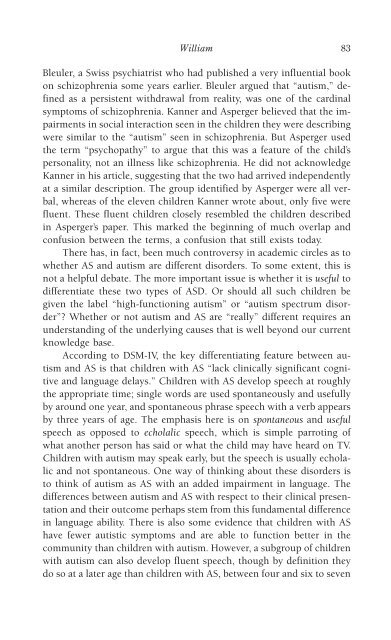978-1572305441
autism
autism
Create successful ePaper yourself
Turn your PDF publications into a flip-book with our unique Google optimized e-Paper software.
William 83<br />
Bleuler, a Swiss psychiatrist who had published a very influential book<br />
on schizophrenia some years earlier. Bleuler argued that “autism,” defined<br />
as a persistent withdrawal from reality, was one of the cardinal<br />
symptoms of schizophrenia. Kanner and Asperger believed that the impairments<br />
in social interaction seen in the children they were describing<br />
were similar to the “autism” seen in schizophrenia. But Asperger used<br />
the term “psychopathy” to argue that this was a feature of the child’s<br />
personality, not an illness like schizophrenia. He did not acknowledge<br />
Kanner in his article, suggesting that the two had arrived independently<br />
at a similar description. The group identified by Asperger were all verbal,<br />
whereas of the eleven children Kanner wrote about, only five were<br />
fluent. These fluent children closely resembled the children described<br />
in Asperger’s paper. This marked the beginning of much overlap and<br />
confusion between the terms, a confusion that still exists today.<br />
There has, in fact, been much controversy in academic circles as to<br />
whether AS and autism are different disorders. To some extent, this is<br />
not a helpful debate. The more important issue is whether it is useful to<br />
differentiate these two types of ASD. Or should all such children be<br />
given the label “high-functioning autism” or “autism spectrum disorder”?<br />
Whether or not autism and AS are “really” different requires an<br />
understanding of the underlying causes that is well beyond our current<br />
knowledge base.<br />
According to DSM-IV, the key differentiating feature between autism<br />
and AS is that children with AS “lack clinically significant cognitive<br />
and language delays.” Children with AS develop speech at roughly<br />
the appropriate time; single words are used spontaneously and usefully<br />
by around one year, and spontaneous phrase speech with a verb appears<br />
by three years of age. The emphasis here is on spontaneous and useful<br />
speech as opposed to echolalic speech, which is simple parroting of<br />
what another person has said or what the child may have heard on TV.<br />
Children with autism may speak early, but the speech is usually echolalic<br />
and not spontaneous. One way of thinking about these disorders is<br />
to think of autism as AS with an added impairment in language. The<br />
differences between autism and AS with respect to their clinical presentation<br />
and their outcome perhaps stem from this fundamental difference<br />
in language ability. There is also some evidence that children with AS<br />
have fewer autistic symptoms and are able to function better in the<br />
community than children with autism. However, a subgroup of children<br />
with autism can also develop fluent speech, though by definition they<br />
do so at a later age than children with AS, between four and six to seven



